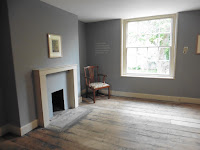 |
| No 8, College Street, Winchester. |
A few weeks ago, I was very privileged to see inside No 8, College Street, Winchester, the house where Jane Austen spent her last few weeks.
Her family hoped that a town doctor, Dr Lydford, might be able to effect a cure for her illness (the cause of which is still not known for certain).
Jane wrote to her nephew James Edward Austen, 'Our lodgings are very comfortable. We have a neat little drawing room with a bow window overlooking Dr Gabell’s Garden'.
 |
| The bow-window at 8 College Street. |
I was very moved to finally see inside the house; I have often seen it from the outside over the years. Of course, I was more sad than excited. How young Jane was! She was still only 41 years old.
After Jane's death, her sister Cassandra wrote mournfully to their niece Fanny Knight: 'I have lost a treasure, such a sister, such a friend as never can have been surpassed. She was the sun of my life, the gilder of every pleasure, the soother of every sorrow; I had not a thought concealed from her, and it is as if I had lost a part of myself'.
Winchester College has renovated the interior, and carefully matched the paint on the walls to traces found during the restoration. The house is currently open to visitors until the end of August (although you may have to wait for a cancellation).













